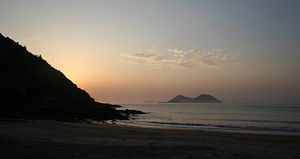On Friday, two Chinese fighters and bombers, in addition to two surveillance aircraft with the People’s Liberation Army Air Force, transited the strategically important Miyako Strait, which lies south of the Japanese island of Okinawa, according to Japan’s Defense Ministry.
The Japanese Air Self-Defense Force (ASDF) scrambled jets in response to the flyby. Though the Chinese aircraft did not enter Japan’s territorial airspace, the proximity of the flyby to Japanese airspace prompted an ASDF response.
As I discussed in The Diplomat, the PLAAF carried out a similar drill in the Miyako Strait in September, which also prompted the Japanese ASDF to scramble fighters in response.
According to a PLAAF spokesperson at the time, that drill included a focus on “reconnaissance and early warning, attacks on sea surface targets, and in-flight refueling to test the Air Force’s fighting capacity on the high seas.”
According to a Japanese Defense Ministry news release on Friday’s flyby, the PLAAF contingent that flew through the Miyako Strait included two H-6 bombers, two Su-30 fighters, and two intelligence-gathering aircraft. In September, the PLAAF had also flown H-6 bombers, Su-30 fighters, and air tankers through the strait.
The H-6 bombers on Friday transited east-to-west through the strait and all aircraft entered the East China Sea from the Western Pacific. China declared a unilateral air defense identification zone (ADIZ) in the East China Sea in 2013.
Friday’s incident in the Miyako Strait also came as Chinese and Japanese officials met in Tokyo for the 6th joint working group consultation on a bilateral maritime and air communication mechanism that would govern encounters between the armed forces of the two countries. The two sides have been working to finalize the mechanism since 2012, but momentum was lost by rising tensions in the East China Sea.
Relations between China and Japan have been strained over maritime disputes in the East China Sea, most notably concerning the sovereignty of the Senkaku/Diaoyu Islands, which Japan administers but China claims. Moreover, Tokyo strongly protested China’s declaration of an ADIZ in 2013.
This year, Chinese naval and coast guard vessels increased incursions into Japan’s territorial sea and contiguous zone in the East China Sea. In June, for example, a People’s Liberation Army-Navy frigate entered the contiguous zone of the Senkaku/Diaoyu Islands for the first time ever.
The PLAAF, in particular, has demonstrated a renewed interest in transiting strategically important passages along the first island chain. In addition to Friday’s incident and the September drill in the Miyako Strait, the PLAAF has conducted multiple transits of the Bashi Channel, the strategically important waterway separating the Philippines’ northern island of Luzon and Taiwan.

































